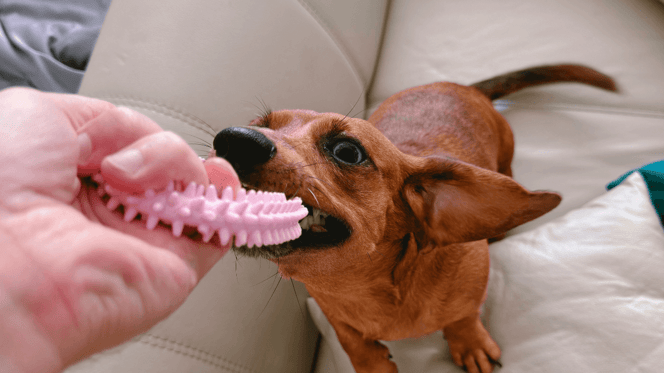Just like babies, puppies go through teething too- and with 28 tiny milk teeth making way for 42 adult ones, this can mean a lot of chewing.
Thankfully, there are plenty of practical strategies you can try to help minimise the damage at home.
What happens during puppy teething?
Puppies typically begin teething at around 3 to 4-months old. As their baby teeth fall out and adult teeth emerge, discomfort often drives them to seek relief by chewing on anything available.
This phase eventually passes, but it can be a challenging time for both puppy and owner. Being prepared and attentive to signs of discomfort can help minimise stress and unwanted damage to your furniture.
Puppy teething symptoms
Teething symptoms include swollen gums, increased drooling, irritability and a strong urge to chew.
You may also notice your pup whimpering during meals, a clear sign they're experiencing discomfort. They may also avoid certain foods entirely, or paw at their mouth in an attempt to ease the sensation.
Puppy teething: five ways to save your furniture
By paying attention to their behaviour and making small changes to their environment and daily routine, you can reduce stress and discomfort.
From providing appropriate outlets to space management, there are several practical ways to support your puppy during this stage of their development- protecting your furniture along the way.
Try the Zigzag app
Sometimes extra guidance can make all difference, particularly if you're feeling overwhelmed by your puppy's teething behaviour.
The Zigzag app offers a personalised, structured plan, with expert advice on how to redirect chewing and biting. With articles and lessons specifically tailored to your puppy's age, the app explains how to teach your puppy to choose specific toys to chew on, how to address nipping and how to relieve discomfort.
There's also professional support available day and night, and a community group where you can connect with other owners facing similar challenges with their four-legged friend.
Set up physical barriers
Management is key when it comes to helping your furniture survive the teething phase.
Take the time to puppy-proof by moving delicate items, checking for hazards, and setting boundaries anywhere your dog has access to.
Dog gates can be used to block off rooms entirely, and you can rearrange furniture to make corners harder to access. You may also want to remove small items like shoes, remotes and magazines, to discourage your puppy from mistaking them for toys.
Offer comfort for sore gums
Frozen items can offer immediate relief for sensitive gums. Soft rubber toys can be placed in the freezer, along with frozen carrots (cut into safe pieces), and broth ice cubes as natural, edible alternatives.
These can all help distract your puppy from furniture and shoes.
Redirect chewing behaviour
Chewing is instinctive and therapeutic for puppies, particularly during the teething phase. It's best to avoid punishing or scolding them. Instead, try redirecting chewing behaviour to appropriate items the puppy has access to, offering positive reinforcement and praise as you do so.
It's a good idea to fill a designated area with safe chew toys, to show your puppy where mouthing is acceptable. This will help reduce confusion and encourage positive long-term habits.
You can also rotate toys, to help keep things interesting.
Exercise and routine
Boredom often leads to an increase in inappropriate chewing, so it's important to provide an outlet for your puppy's energy, along with plenty of mental stimulation.
Routine, interactive play sessions and gentle socialisation can help keep your pup out of mischief at home.
When do puppies stop teething?
Around three to four months, your puppy's milk teeth begin to fall out as adult teeth emerge. By six to seven months, most puppies have all 42 adult teeth in place, although larger breeds may take a little longer- sometimes up to eight months.
While teething can be challenging, it's a natural and temporary phase of development. Understanding what’s happening and providing the right support can make it much easier for both you and your puppy. With patience, consistent guidance, and a few practical strategies, you can help your puppy navigate this stage while keeping your belongings safe.

